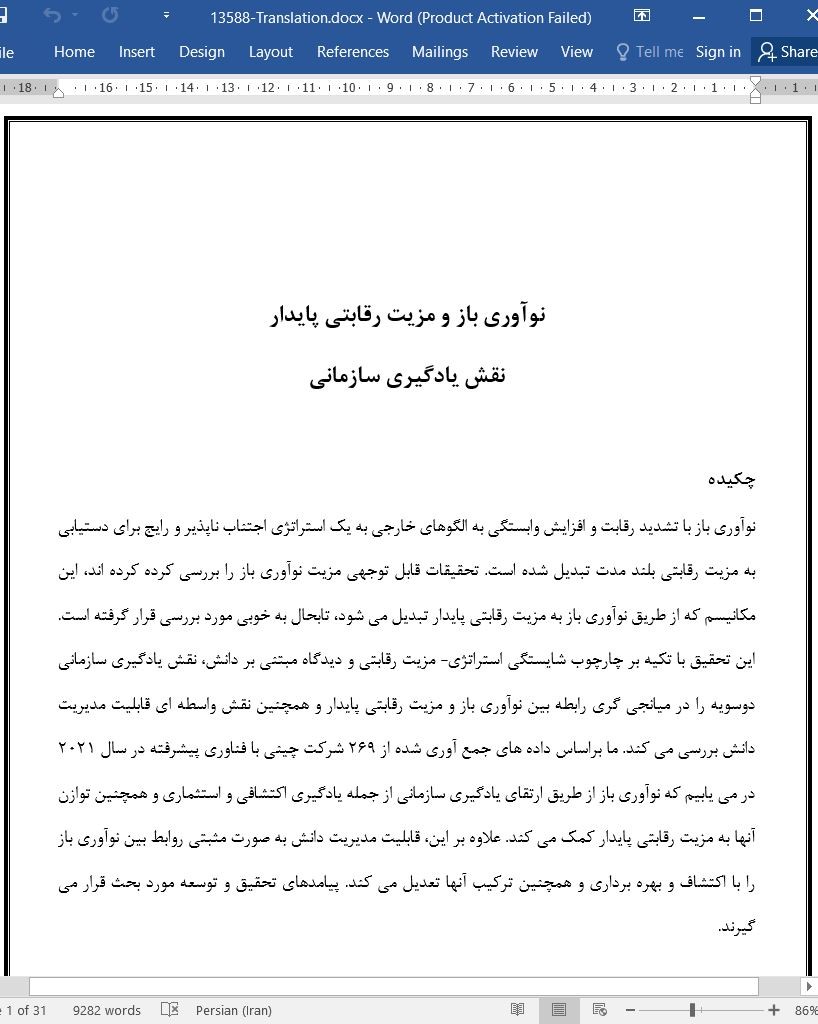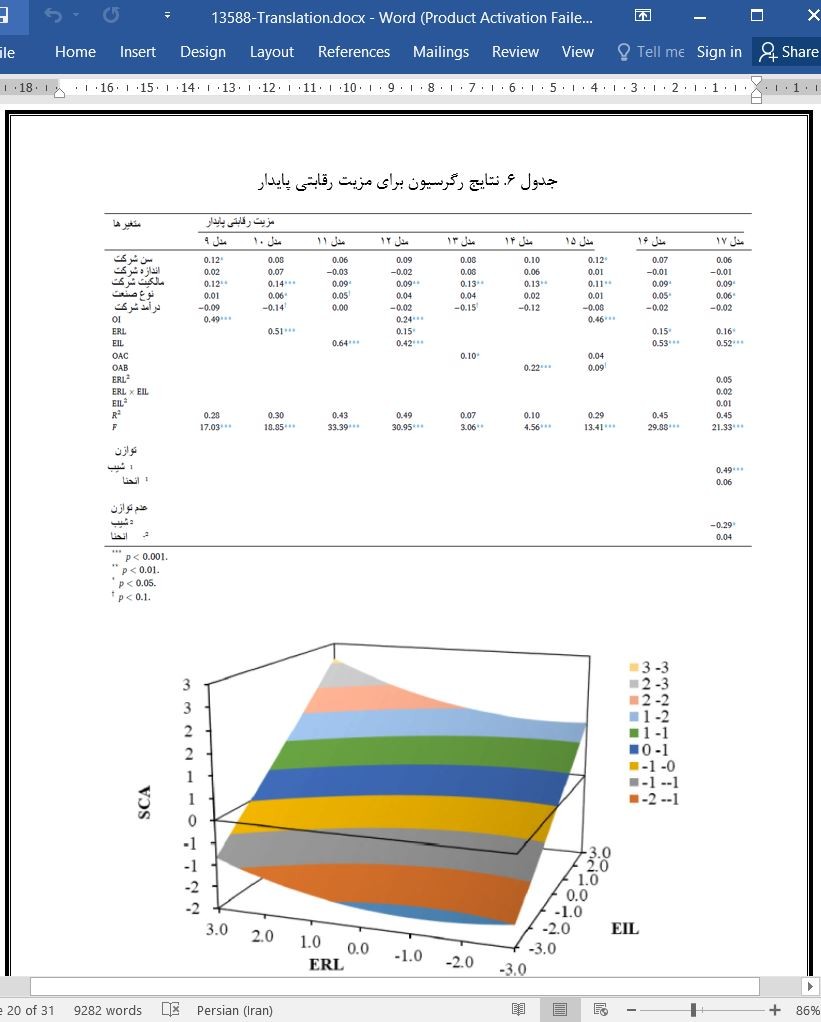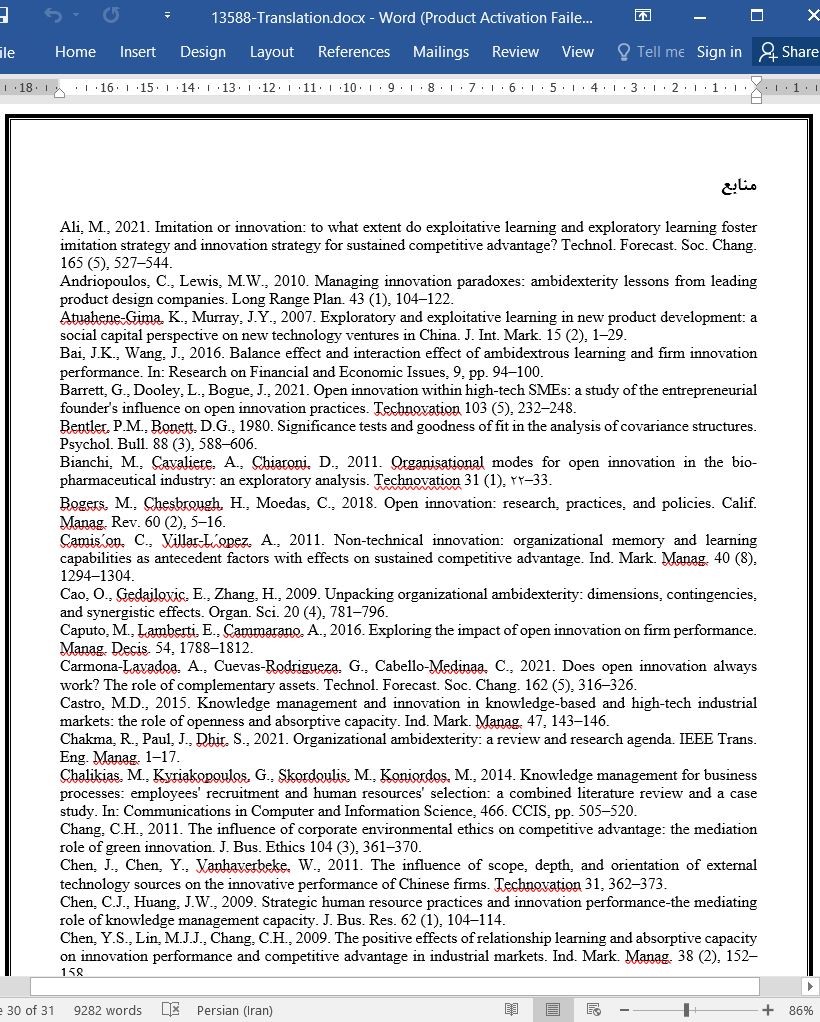
دانلود مقاله نوآوری باز و مزیت رقابتی پایدار نقش یادگیری سازمانی
چکیده
نوآوری باز با تشدید رقابت و افزایش وابستگی به الگوهای خارجی به یک استراتژی اجتناب ناپذیر و رایج برای دستیابی به مزیت رقابتی بلند مدت تبدیل شده است. تحقیقات قابل توجهی مزیت نوآوری باز را بررسی کرده کرده اند، این مکانیسم که از طریق نوآوری باز به مزیت رقابتی پایدار تبدیل می شود، تابحال به خوبی مورد بررسی قرار گرفته است. این تحقیق با تکیه بر چارچوب شایستگی استراتژی- مزیت رقابتی و دیدگاه مبتنی بر دانش، نقش یادگیری سازمانی دوسویه را در میانجی گری رابطه بین نوآوری باز و مزیت رقابتی پایدار و همچنین نقش واسطه ای قابلیت مدیریت دانش بررسی می کند. ما براساس داده های جمع آوری شده از 269 شرکت چینی با فناوری پیشرفته در سال 2021 در می یابیم که نوآوری باز از طریق ارتقای یادگیری سازمانی از جمله یادگیری اکتشافی و استثماری و همچنین توازن آنها به مزیت رقابتی پایدار کمک می کند. علاوه بر این، قابلیت مدیریت دانش به صورت مثبتی روابط بین نوآوری باز را با اکتشاف و بهره برداری و همچنین ترکیب آنها تعدیل می کند. پیامدهای تحقیق و توسعه مورد بحث قرار می گیرند.
1. مقدمه
در نتیجه جهانی شدن، پیچیدگی فنی باعث افزایش رقابت و کمبود منابع شد، سازمان ها در حال تغییر هستند و یک رویکرد رقابتی باز تر برای مزیت رقابتی خودشان اتخاذ می کنند (بارت و همکاران، 2021؛ لویس و همکاران، 2010). بنابراین، نوآوری باز به یک مفهوم مهم در تحقیق دانشگاهی و شیوه صنعتی تبدیل شده است؛ نوآوری باز به ترتیب به «استفاده از جریان های ورودی هدفمند و جریان های خروجی دانش برای تسریع نوآوری داخلی و توسعه بازارها برای استفاده خارجی از نوآوری اشاره می کند» (چسبروگ، 2006). نوآوری باز در مقایسه با نوآوری بسته به شرکت ها اجازه می دهد تا دانش خارجی را کشف کنند و از بیرون منابع داخلی موجود را برای بدست آوردن مرز رقابتی استثمار کنند (درچسلر و ناتر، 2012؛ پوپا و همکاران، 2017). یک کسب و کار هرچه بیشتر با سایر سازمان ها تعامل داشته باشد، احتمال بدست آوردن ایده های خارجی، توانایی ها، دانش، فناوری و سایر موارد نامشهود بیشتر می شود، و احتمال بیشتری برای نوآوری موفق دارد (گرکو و همکاران، 2016). علاوه بر این، تکمیل و همکاری منابع نواوری داخلی و خارجی به تدریج قابلیت نوآوری ذاتی شرکت ها را بهبود می دهد، در نهایت به آنها کمک می کند تا رقابت اصلی خودشان را شکل دهند (لیچتنتالر، 2011).
7.4. محدودیت ها و تحقیقات آینده
این تحقیق چندین محدودیت دارد و ابتدا، این تحقیق تنها اثر میانجی یادگیری سازمانی را بررسی می کند. اما با منطق SCC، انواع زیادی از شایستگی ها نقش تبدیل استراتژی نوآوری باز به مزیت رقابتی را بر عهده می گیرند. تحقیقات بیشتر ممکن است سایر مکانیسم های میانجی مانند قابلیت های پویا و قابلیت های تطبیقی را در این میان بررسی کنند. دوم، این تحقیق تنها اثر میانجی قابلیت مدیریت دانش را در نظر می گیرد تا به حل یافته های متناقض در مورد رابطه بین نوآوری باز و مزیت رقابتی کمک کند. ممکن است که تحقیقات آینده با بررسی عوامل دیگر (مانند عوامل صنعتی، شخصیت های مدیران و غیره) که بر چنین رابطه ای تاثیر می گذارد، این مسئله را حل کنند. سوم، استفاده از داده های مقطعی جمع آوری شده توسط نظرسنجی ممکن است محدودیت دیگری باشد، زیرا نمی تواند روابط موقتی میان نوآوری باز، یادگیری استثماری و اکتشافی، و مزیت رقابتی پایدار را تفسیر کند (لاتان، 2018؛ لاتان و همکاران، 2019؛ اولا و همکاران، 2018). تحقیقات آینده ممکن است با در نظر گرفتن موضوع درون زایی از داده های ترکیبی برای بررسی این روابط استفاده کنند. چهارم، ضمن اینکه این داده ها از شرکت های مستقر در ناحیه دلتای رودخانه یانگ تسه جمع آوری شد، و نمونه نسبتا کوچک بود، که ممکن است بر تعمیم پذیری نتایج تا حدی تاثیر بگذارد.
Abstract
With intensifying competition and increasing dependence on external partners, open innovation has been becoming an inevitable and prevalent strategy to achieve long-term competitive advantage. Considerable research has investigated the benefit of open innovation, the mechanism through which open innovation translates into sustainable competitive advantage have yet been well examined. Drawing on the strategy-competence-competitive advantage framework and the knowledge-based view, this study examines the role of ambidextrous organizational learning in mediating the relationship between open innovation and sustainable competitive advantage as well as the moderating role of knowledge management capability. Based on data collected from 269 Chinese high-tech enterprises in 2021, we found that open innovation contributes to sustainable competitive advantage through enhancing organizational learning including both exploratory and exploitative learning as well as their balance. Moreover, knowledge management capability positively moderates the relationships of open innovation to exploration and exploitation as well as their combination. Research and practical implications are discussed.
1. Introduction
As a result of globalization, technological complexity, increased competition and resource scarcity, organizations are changing and adopting a more open, cooperative approach to building their competitive advantage (Barrett et al., 2021; Lewis et al., 2010). Hence, open innovation has been becoming an important concept in both academic research and industrial practice; it refers to “the use of purposive inflows and outflows of knowledge to accelerate internal innovation, and expand the markets for external use of innovation, respectively” (Chesbrough, 2006). Compared with closed innovation, open innovation permits firms to explore outside knowledge and to externally exploit existing internal resources to gain a competitive edge (Drechsler and Natter, 2012; Popa et al., 2017). The more a business interacts with other organizations, the higher its chances of acquiring external ideas, capabilities, knowledge, technology and other intangibles, and the greater its chances of successful innovation (Greco et al., 2016). Moreover, the complementarity and collaboration of internal and external innovation resources will gradually improve enterprises' innate innovation capability, helping them to ultimately form their own core competitiveness (Lichtenthaler, 2011).
7.4. Limitations and future studies
This study has several limitations. First, this study only examines the mediating effect of organizational learning. But, with the logic of SCC, many kinds of competences take the roles of transforming open innovation strategy into competitive advantage. Future research may explore other mediation mechanisms such as dynamic capabilities, adaptive capabilities, among others. Second, this study only examines the moderating effect of knowledge management capability to help resolve the inconsistent findings on the relationship between open innovation and competitive advantage. Future studies may further to resolve this problem by investigating other factors (such as industrial factors, managers' personalities, among others) that affect such relationship. Third, the using cross section data collected by survey may be another limitation, as it fails to interpret the temporal relationships among open innovation, exploitative and exploratory learning, and sustainable competitive advantage (Latan, 2018; Latan et al., 2019; Ullah et al., 2018). Future works may employ panel data to examine these relationships with considering the issue of endogeneity. Fourth, while the data was collected from firms locating in the Yangtze River Delta region, and the sample was relatively small, which may affect the generalizability of the conclusions to some extent.
H1. Open innovation has a positive association with sustainable competitive advantage.
H2a. Exploitative learning positively mediates the relationship between open innovation and sustainable competitive advantage.
H2b. Exploratory learning positively mediates the relationship between open innovation and sustainable competitive advantage.
H3a. OAC positively mediates the relationship between open innovation and sustainable competitive advantage.
H3b. OAB positively mediates the relationship between open innovation and sustainable competitive advantage.
H4a. Knowledge management capability positively moderates the relationship between open innovation and exploitative learning.
H4b. Knowledge management capability positively moderates the relationship between open innovation and exploratory learning.
H4c. Knowledge management capability positively moderates the relationship between open innovation and OAC.
H4d. Knowledge management capability positively moderates the relationship between open innovation and OAB.
H1. نوآوری باز ارتباط مثبتی با مزیت رقابتی پایدار دارد.
H2a. یادگیری استثماری میانجی مثبت رابطه بین نوآوری باز و مزیت رقابتی پایدار است.
H2b. یادگیری اکتشافی میانجی مثبت رابطه بین نوآوری باز و مزیت رقابتی پایدار است.
H3a. OAB میانجی مثبت رابطه بین نوآوری باز و مزیت رقابتی پایدار است.
H3b. OAB میانجی مثبت رابطه بین نوآوری باز و مزیت رقابتی پایدار است.
H4a. قابلیت مدیریت دانش میانجی مثبت رابطه بین نوآوری باز و یادگیری استثماری است.
H4b. قابلیت مدیریت دانش میانجی مثبت رابطه بین نوآوری باز و یادگیری اکتشافی است.
H4c. قابلیت مدیریت دانش میانجی مثبت رابطه بین نوآوری باز و OAC است.
H4d. قابلیت مدیریت دانش میانجی مثبت رابطه بین نوآوری باز و OAB است.
Firm age
Firm size
Firm ownership
Industry type
Firm revenue
OI
ERL
EIL
OAB
OAC
KMC
SCA
M
SD
چکیده
1. مقدمه
2. پیشینه نظری
2.1. نوآوری باز
2.2. یادگیری سازمانی
2.3. ادغام چارچوب SCC و KBV
3. فرضیه ها
3.1. نوآوری باز و مزیت رقابتی پایدار
3.2.. نقش میانجی اکتشاف و استثمار
3.3. نقش میانجی دوسو توانی سازمانی
3.4.. نقش میانجی قابلیت مدیریت دانش
4. روش ها
4.1. جمع آوری داده ها
4.2. معیارها
4.2.1. یادگیری استثماری و اکتشافی
4.2.2. نوآوری باز
4.2.3. توانایی مدیریت دانش
4.2.4. مزیت رقابتی پایدار
5. تحلیل
5.1. پایایی و روایی
5.2. ارزیابی سوگیری روش مشترک (CMB)
6. نتایج
6.1. آزمایش فرضیه
6.2. تحلیل موقتی (اد هاک)
6.3. آزمون استواری
7. بحث
7.1. تاثیر نوآوری باز بر مزیت رقابتی
7.2. نقش میانجی یادگیری سازمانی دوسو توان
7.3. نقش میانجی قابلیت مدیریت دانش
7.4. محدودیت ها و تحقیقات آینده
فهرست کلمات اختصاری
بیانیه مشترک تالیف CRediT
تامین مالی
در دسترس بودن داده ها
ضمیمه I. پرسشنامه نظرسنجی
تامین مالی
منابع
Abstract
1. Introduction
2. Theoretical background
2.1. Open innovation
2.2. Organizational learning
2.3. Integrating the SCC framework and the KBV
3. Hypotheses
3.1. Open innovation and sustainable competitive advantage
3.2. The mediating role of exploration and exploitation
3.3. The mediating role of organizational ambidexterity
3.4. The moderating role of knowledge management capability
4. Methods
4.1. Data collection
4.2. Measures
4.2.1. Exploitative and exploratory learning
4.2.2. Open innovation
4.2.3. Knowledge management capability
4.2.4. Sustainable competitive advantage
5. Analysis
5.1. Reliability and validity
5.2. Common method bias (CMB) assessment
6. Results
6.1. Hypothesis testing
6.2. Post hoc analysis
6.3. Robustness test
7. Discussion
7.1. The impact of open innovation on competitive advantage
7.2. The mediating role of ambidextrous organizational learning
7.3. The moderating role of knowledge management capability
7.4. Limitations and future studies
The nomenclature of acronyms
CRediT authorship contribution statement
Funding
Appendix I. Survey questionnaire
Data availability
References
Vitae
این محصول شامل پاورپوینت ترجمه نیز می باشد که پس از خرید قابل دانلود می باشد. پاورپوینت این مقاله حاوی 24 اسلاید و 6 فصل است. در صورت نیاز به ارائه مقاله در کنفرانس یا سمینار می توان از این فایل پاورپوینت استفاده کرد.
در این محصول، به همراه ترجمه کامل متن، یک فایل ورد ترجمه خلاصه نیز ارائه شده است. متن فارسی این مقاله در 9 صفحه (1900کلمه) خلاصه شده و در داخل بسته قرار گرفته است.
علاوه بر ترجمه مقاله، یک فایل ورد نیز به این محصول اضافه شده است که در آن متن به صورت یک پاراگراف انگلیسی و یک پاراگراف فارسی درج شده است که باعث می شود به راحتی قادر به تشخیص ترجمه هر بخش از مقاله و مطالعه آن باشید. این فایل برای یادگیری و مطالعه همزمان متن انگلیسی و فارسی بسیار مفید می باشد.
بخش مهم دیگری از این محصول لغت نامه یا اصطلاحات تخصصی می باشد که در آن تعداد 55 عبارت و اصطلاح تخصصی استفاده شده در این مقاله در یک فایل اکسل جمع آوری شده است. در این فایل اصطلاحات انگلیسی (تک کلمه ای یا چند کلمه ای) در یک ستون و ترجمه آنها در ستون دیگر درج شده است که در صورت نیاز می توان به راحتی از این عبارات استفاده کرد.
- ترجمه فارسی مقاله با فرمت ورد (word) با قابلیت ویرایش و pdf بدون آرم سایت ای ترجمه
- پاورپوینت فارسی با فرمت pptx
- خلاصه فارسی با فرمت ورد (word)
- متن پاراگراف به پاراگراف انگلیسی و فارسی با فرمت ورد (word)
- اصطلاحات تخصصی با فرمت اکسل



